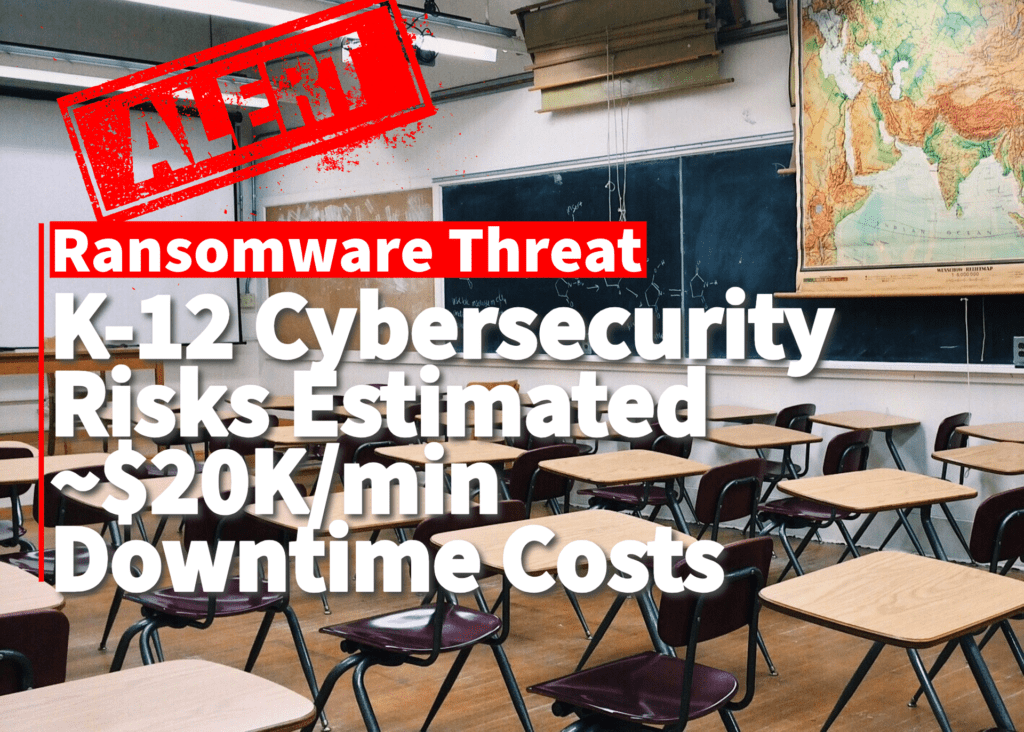Federal and State Responses to the K-12 Cybersecurity Crisis: The Alarming Increase in Ransomware Attacks on K-12 Schools
Cybersecurity in Crisis: The Growing Threat to K-12 Schools
As our educational institutions increasingly rely on digital tools, the vulnerability of K-12 schools to cyberattacks has never been more pronounced. Recent trends indicate a worrying rise in ransomware attacks targeting these institutions, jeopardizing the personal data of students and the operational integrity of schools. The stakes are high, with hackers exploiting the relative lack of robust cybersecurity measures in the education sector. This comprehensive analysis delves into the criticality of these threats, the impact on the educational ecosystem, and actionable steps to mitigate the risks using a Zero Trust approach to improve K-12 cybersecurity results designed to help protect the kids and staff.

What Happened – Cyberattacks Against K-12 Education
In recent years, K-12 schools have become prime targets for cybercriminals, with ransomware attacks causing significant disruptions. According to a 2023 report by Education Week, the frequency and sophistication of these attacks have escalated, leading to extended school closures, loss of sensitive data, and substantial financial costs for recovery. These attacks often exploit outdated software and inadequate security protocols, making schools easy prey for hackers seeking to extract ransoms.
Technically What Happened – Cybersecurity Threats & Ransomware
Ransomware attacks on K-12 schools typically involve malicious software that encrypts the school’s data, rendering it inaccessible until a ransom is paid. Hackers gain entry through phishing emails, exploiting vulnerabilities in the school’s network. The initial breach often occurs via compromised credentials or unpatched software, allowing the attackers to deploy the ransomware across the network. Once the system is encrypted, the attackers demand a ransom, usually in cryptocurrency, for the decryption key.
Criticality Score of Threat of Cyber Incidents at K-12 Organizations
On a scale of 1 to 10, the criticality of ransomware threats to K-12 schools is rated at 9. This high rating reflects the severe operational and financial impacts of these attacks, coupled with the sensitive nature of the data at risk, including student records, financial information, and personal details of staff and students.
Why It Matters to K-12 Cybersecurity
The impact of these attacks is profound. For students, it can mean the loss of vital educational resources and personal information. For schools, the financial burden of recovery and ransom payments can be crippling. Additionally, the trust of parents and the community in the school’s ability to safeguard their children’s data is eroded. The educational sector, already grappling with budget constraints, is ill-equipped to handle the sophisticated nature of these cyber threats.
K-12 Schools & Federal Response
In response to the escalating threat, federal and state agencies, including the Cybersecurity and Infrastructure Security Agency (CISA), have launched initiatives to bolster the cybersecurity posture of K-12 schools. The Biden-Harris Administration has announced several measures, including increased funding for cybersecurity programs and the implementation of stricter security protocols for educational institutions to enhance K-12 cybersecurity.
What Can K-12 Education and Organizations Do Now to implement Best Practices to Mitigate Cyberattack Risks?
For schools, adopting a proactive cybersecurity strategy is crucial. This includes:
- Changing Vendors: Evaluate current cybersecurity vendors and consider switching to those with proven track records in protecting educational institutions.
- Criteria to Change Vendors: Look for vendors offering comprehensive security solutions, including advanced threat detection, regular software updates, and 24/7 monitoring.
- If Affected: If your school has been targeted, immediately disconnect affected systems, notify law enforcement, and engage a professional cybersecurity firm to assist in recovery and prevention of future attacks.
Mitigation Strategies – Data Security and Privacy Risks Schools Face
- Implementing Zero Trust Architecture: Adopt a Zero Trust security model to ensure that all users, whether inside or outside the network, are authenticated, authorized, and continuously validated before gaining or maintaining access to applications and data.
- Regular Software Updates: Ensure all systems are up to date with the latest security patches.
- Phishing Training: Educate staff and students on recognizing and avoiding phishing emails.
- Strong Password Policies: Implement strong password policies and multi-factor authentication.
- Backup Data: Regularly back up critical data and store backups offline to prevent ransomware encryption.
- Incident Response Plan: Develop and regularly update an incident response plan to swiftly address potential breaches.
Strategic Truths for K-12 School Districts
The rising tide of cyber threats against K-12 schools underscores a fundamental truth: cybersecurity is not just an IT issue but a critical aspect of educational integrity and safety. Schools must view cybersecurity as an integral part of their operational framework, akin to physical security measures. Embracing a Zero Trust approach can significantly enhance the K-12 cybersecurity posture by reducing the attack surface and ensuring continuous monitoring and validation of all network interactions.
Summary Wrap-Up – Cybersecurity and Infrastructure Security for K-12 Schools
The surge in ransomware attacks on K-12 schools is a pressing issue that demands immediate and sustained attention. By understanding the nature of these threats, their potential impact, and the steps required to mitigate them, educational institutions can better protect their data and ensure the continuity of learning. As cybersecurity threats evolve, so too must our defenses, underscoring the need for ongoing vigilance and investment in robust K-12 cybersecurity measures, particularly through the adoption of Zero Trust principles.
Sources
- Education Week Article
- K-12 Dive Article on CISA Ed Tech Pledge
- K-12 Dive Article on Ransomware Attacks
- White House Briefing Room
- K-12 Dive Article on Feds Announcing K-12 Cybersecurity Supports
- Cyber Strategy Institute – Business Warden
- Cyber Strategy Institute
- Cyber Strategy Institute – CrowdStrike Compromised
- Cyber Strategy Institute – Warden’s Zero Trust Endpoint Defense
- Cyber Strategy Institute – Zero Trust Architecture Implementation





